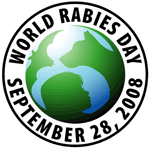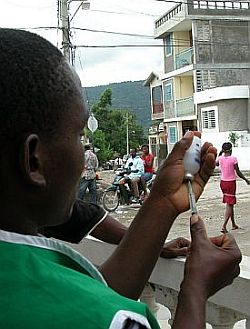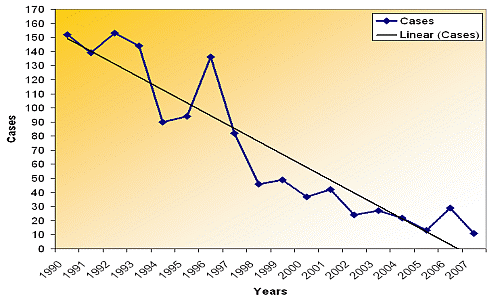World Rabies Day 2008
Rabies in humans is 100% preventable through prompt appropriate medical care but more than 55,000 people die each year

Despite a reduction by 90% in human and canine cases in the Americas, the Pan American Health Organization says that more coordinated action is needed at all levels to work together with clear determination and help make rabies history. World Rabies Day 2008 will take place September 28th.
Washington, D. C., September 8, 2008 (PAHO)—Rabies in humans is 100% preventable through prompt appropriate medical care. Yet, more than 55,000 people die each year, mostly in areas of the world which still have the "dog-to-dog" type of rabies transmission.
This major source of rabies in humans can be eliminated through ensuring adequate animal vaccination and control, educating those at risk, and enhancing access of those bitten to appropriate medical care, which may include post-exposure prophylaxis with vaccine. Within the last decade, major decreases in human rabies deaths have been achieved in the Americas through coordinated vaccination of dogs leading to rabies elimination in local animal populations. Rabies control in dogs leads to better health for both dogs and humans.

(Key measures for human rabies control include intensification of dog vaccination, intensification of foci control, decentralization of post-exposure treatment, creation of a legal framework, sensitization of both the authorities and the population, and allocation of funds specifically for rabies control. Photos reflect a Dec. 07 vaccination campaign in Haiti.)
Rabies prevention is important no matter where we live because humans travel, animals are moved, and bats, which are a potential source of rabies throughout the world, fly.
During the inaugural World Rabies Day 2007, 74 countries participated through activities such as prevention messages for the public, dog vaccination campaigns, press conferences, parades and more. Based on website communications from over 180 countries and other indicators, the second World Rabies Day on September 28th of this year shows promise for participation by a majority of countries of the world.
The World Rabies Day campaign is a community of people working together towards human rabies prevention and animal rabies control. The main objectives of World Rabies Day are to raise awareness, education, and resources. Some of the partners are the Alliance for Rabies Control (ARC), veterinary student associations, World Health Organization (WHO), Pan American Health Organization (PAHO) and World Organization for Animal Health (OIE), the Centers for Disease Control and Prevention (CDC), universities, professional associations of physicians and veterinarians and also community groups at the local level throughout the world. Thanks to a variety of activities at different levels, governments in the Americas are also doing a big effort to achieve the overall goal of eliminating this disease in the hemisphere.
Through broad collaboration, this initiative will catalyze momentum to reduce inequities that lead to human rabies cases and uncontrolled canine rabies. These efforts are envisioned to be part of comprehensive human and animal health delivery that would develop and augment public health and veterinary infrastructure in regions of greatest need.

"Through the World Rabies Day initiative, we are indeed -as stated by the 2008 slogan- working together to make rabies history", said Dr. Cristina Schneider, from PAHO. The expert said that "successful efforts in the Americas, for example, have proved that rabies can be eliminated in dogs. Throughout the Region, the number of human and canine cases has been reduced by 90%, and the Region expects to achieve its goals of eliminate human rabies transmitted by dog and later dog-to-dog transmission".
US$1000 Competition
The Alliance for Rabies Control, together with the Pan American Health Organization / Veterinary Public Health / PANAFTOSA, is hosting a competition for the best rabies prevention and control event to commemorate World Rabies Day (WRD) in Latin America and the Caribbean on 28 September 2008. A PAHO certificate will be awarded to each team along with a WRD prize of US$ 1,000 to be spent on materials to be used in next year's World Rabies Day 2009. For complete information about the competition, click on AWARD and open the appropriate link.
Dr. Fernando Leanes, from PANAFTOSA/PAHO, emphasized that the purpose of this competition is "to serve as a beneficial learning experience for the competing teams and thus encourage them to participate in Working together to make rabies history".

(Human rabies transmitted by dogs, Latin America, 1990-2007)
Links:
- PAHO World Rabies Day 2008 site
- World Rabies Day 2008 website
- World Rabies Day logos to download
- Comprehensive rabies education materials
PAHO, founded in 1902, works with all the countries of the Americas to improve the health and quality of life of their peoples. It also serves as the Regional Office for the Americas of the World Health Organization (WHO).
| 60 Years of the WHO 60 Aņos de la OMS |